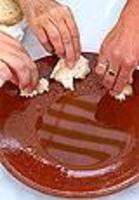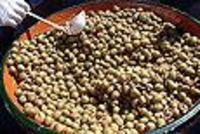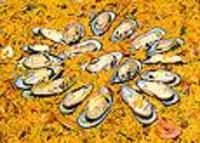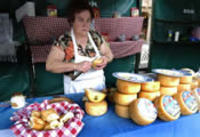

The Spanish, like many Latin cultures, make the mid–day meal their biggest, stretching it out for hours. From midday to mid–afternoon, everything shuts down, except of course for the restaurants. Then, after this long, leisurely meal (and sometimes a nap) they return to their workplaces and continue into the night.
The evening meal is late, anywhere from about 9pm to midnight. While most of us are not accustomed to eating dinner so late, you might consider indulging in the Spanish favourite, tapas, as a light supper, although no real Spaniard would ever do this.
Restaurant hours are typically 1:00pm – 4:30pm for lunch and 9:00pm to 12:00 midnight for dinner. Though this may vary in the tourist areas, so always check your chosen restaurant.
Menu del Día – Though not usually very exciting, this fixed price meal is required of restaurants. It’s a great way to taste some standard Spanish food, without the worry of a long menu. The prices for a menu del día almost always include bread, water and wine or beer, with a coffee at the end. They are very good value.
Menu – The principal ingredients of local Murcian dishes are the fresh produce of the Huerta (market garden – the fields of Murcia) and rice, fish and seafood from the nearby Mar Menor and the Mediterranean Sea.

Excellent choices are the king prawns and the “huevas de mújol” which is a local variety of caviar. The region also produces fine wines among which the most known are Jumilla and Yecla.
“Tapas” are snacks designed to be served with your drink. It’s widely believed that the name comes from the custom of the barman covering your glass of sherry with a slice of bread, cheese, or salami to keep the flies from drinking too much – “tapar” means to cover in Spanish.
However research suggests that the King Alfonso X el Sabio, who is said to have refused to serve his glorious wine to visitors unless they also had something to eat, introduced the term – he would “tapaba” them.
Madrid is probably the best known “tapas” destination, but the tradition is observed in many parts – especially in the southern half of the country. There are two approaches to tapas: one is a “freebie”, a mouthful that comes with the price of your drink (often called a “pincho”). The second is a side–order snack purchased to accompany your glass of local wine.
Spaniards go to bars to chat, meet friends, argue, joke and flirt. Tapas are provided to keep them going and encourage the sales of drinks. Tapas are rarely eaten instead of a main meal but are good for soaking up the wine. Some of the best tapas bars can be found by universities and where commuters might congregate. This makes Murcia city a haven of tapas.
Each region has it’s own specialities; in fact each bar also has its own favourites. Here is a selection you might meet (or eat!):
Jamón – ham off the bone, cut to order in almost all bars and restaurants. You’ll see the leg on a special holder at the bar and often you’ll see many legs hanging from the ceiling (with their little upside down umbrellas to catch the fat). The Jamón is taken seriously in Spain, with a number of varieties including Iberico, Serrano and Bellota.
Patatas Alioli – Boiled potatoes, in a creamy Alioli sauce (raw garlic mayonnaise) topped with a sprinkle of parsley.
Patatas Bravas – Potatoes with a hot mustard, tomato and Tabasco sauce.
Tortilla – A fat omelette made with potatoes which sometimes includes peas, meat, tuna, peppers or mushrooms. Magras con Tomate – Fried pork cooked in a sweet tomato sauce. Calamares – Fried, beautifully fresh calamari, that melts in your mouth and Calamares en su tinta, squid in their own ink.
Aceitunas – Olives – big, fat olives, often with stalks intact, firm to bite.

Pollo al Ajillo con Vino – Garlic chicken with wine
Caldo en Albóndigas – Meatballs in a watery soup (consommé)
Gazpacho – Cold tomato soup, almost like a salad, only usually available in the summer, unfortunately!
Revuelto – Revuelto is a common name for another tapas counter staple – eggs scrambled with runner beans, garlic, onions and ham.
Zarangollo – Zarangollo is a Murcian dish combining the concepts of ratatouille and omelette. It is made from tomatoes, courgettes, onions and eggs. Every tapas bar worth its salt in the region should have a plateful in the chiller. Menestra is similar, a dish of sautéed vegetables
Ensalada Murciana – A wet salad of cooked red peppers and tomatoes, garlic, aubergine and onions. Always served cold and frequently with some fish (tuna or cod) thrown in. Almost always on the tapas counter.
Pastel de carne – Little pasty or pie shaped pastries, filled with delicious meat, tomato and egg. Very good, give it a try.
Arroz – Rice is grown in the Calasparra region, with it’s own quality standards. Among the wide variety of rice dishes are:

Potaje – a rich stew dish
Habas con jamón – ham and broad beans
Caldo murciano – local soup dish
Chuletas al ajo cabañil – garlic chops
Pescado a la sal – baked fish in salt
Fresh Vegetables & Fruit – Known as the market garden ( huerta), the Murcia region boasts an extensive and year round fruit and veg selection. Many of the fruit and vegetables you’ll find in supermarkets in the UK will have come from Murcia – particularly tomatoes, melons and oranges.
Wild Boar – Jabalí is available as a delicacy throughout Spain, and Murcia is no exception. The boar is served in a number of dishes (including the famous wild boar with figs) as well as just roasted.
Cheeses – The best cheeses in Murcia are granted a DOC rating, just like the wines of Yecla, Jumilla and Bullas. There are two categories of the Murcia DOC cheese, ‘Queso de Murcia’ and ‘Queso de Murcia al Vino’. The Murcia DOC cheeses are all produced from whole milk from Murciano–Granadina goats.

The ‘Queso de Murcia’ DOC comes in two varieties, fresh and semi–cured. The fresh variety is mild, white and has a woven texture on the rind from the tall, cylindrical mold. The cured variety is cured for at least 60 days, is rather more flavoured with a firmer texture, some holes and a smooth rind.
The ‘Queso de Murcia al Vino’ DOC is a richer cheese with a characteristic reddish colour which comes from the wine that the cheese is soaked in while maturing. The cheese is matured for at least 45 days for large moulds, and 30 days for smaller cheeses.
Caviar – A locally–produced variant of caviar ( huevas de mújol) is produced on the Mar Menor. It’s available in jars in most local supermarkets at a very reasonable price compared to ‘the real thing’ – but tastes pretty good!
Being a vegetarian in Murcia can sometimes be a little challenging. Local culture celebrates the pig and ham as a staple food, to be consumed at every opportunity. Here is a list of the top 3 vegetarian options:
"SIN CARNE?" When ordering for a vegetarian friend in a long–established restaurant in Murcia, we ordered the safe option – revueltos ‘ sin carne’. When it arrived we had to explain that even the little bits of ham in the eggs weren’t appetising to our friend and asked if they wouldn’t mind starting again without meat, and without jamón.
This is an extract from A Brit's Scrapbook: Going Native In Murcia by Debbie Jenkins and Marcus Jenkins. It is a comprehensive guide to investing, holidaying and living in Murcia and the Costa Cálida.